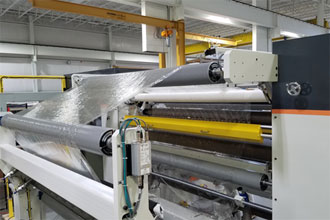by Joe Connelly , Product Manager – Slitting and Winding

At its core, a slitter rewinder has one primary function, to unwind a mill roll and convert it into multiple smaller rolls. This function may sound straight forward, but these machines can be anything but simple. They are typically engineered to handle a wide variety of materials, each with their processing requirements. There is a lot to consider when choosing the best options for an application. One of those options is choosing the best web entry path from the unwind stand to the slitting and rewinding section.
In most slitting and rewinding systems, the unwind is usually a separate unit with the web spanning between it and the rewinder. Material coming from the unwind can either pass overhead or down low, close to the floor, before feeding into the slitting section. There are also cases where the unwind is an integral part of the rewinder, and the web follows a shorter and more direct path to the slitting section. The style of web path is chosen out of personal preference, for consistency with existing equipment, or to accommodate some auxiliary process. However, for those that are not sure which path the web should take, here is some insight.
A parent roll of material to be converted is typically brought to a process using a lift truck, cart, or in-floor conveying system. Generally, these systems keep the parent roll reasonably close to or on the floor before loading. Once loaded into the unwind stand, the parent roll is suspended off the ground just enough to allow it to turn and pay the web into the downstream process. Therefore, the most direct web path is to keep the web low and feed it directly to the slitting section. As this area needs frequent operator access to setup or adjusts the slitting knives, an operator platform is installed over the web to access the machine. Unwinds that are integrated into the slitter rewinder do not require a platform, are more compact, and typically require less floor space. A more direct web path means fewer rollers, less influence on tracking or tension challenges, and a less expensive solution. However, a downside to conveying the web under a platform is the tendency for dust or other debris to contaminate the web. Steps can be taken to remove the electrostatic charge from the web to prevent dust from clinging to it, but any time you convey the web near the floor, the potential for contamination exists.
This is where an overhead web path can be a benefit. Not only does it get the web up in the air and away from the floor, but it can also provide the room for adding other production requirements -- such as visual or optical inspection, surface treatment, and scanning, laminating, laser perforating, or printing, by utilizing the space between the unwind and rewind more efficiently. But, like anything else, some disadvantages come with the advantages.
If an overhead hoist is required for slitting tooling changes (unless there is a slide-out feature for removing it through the side of the machine), then an overhead web path above the slitting section would interfere. Thus, the web would have to be cut and removed first, which can be an inconvenience.
This web path can also require additional idlers and framework, which can add cost and increase the potential for web tension and tracking issues.
It is always best to know all your converting requirements and the potential for future auxiliary processes before deciding on a converting system’s web path configuration. If you have any questions about Dusenbery Converting Systems slitter rewinders or have an application that you would like to discuss, please contact us.